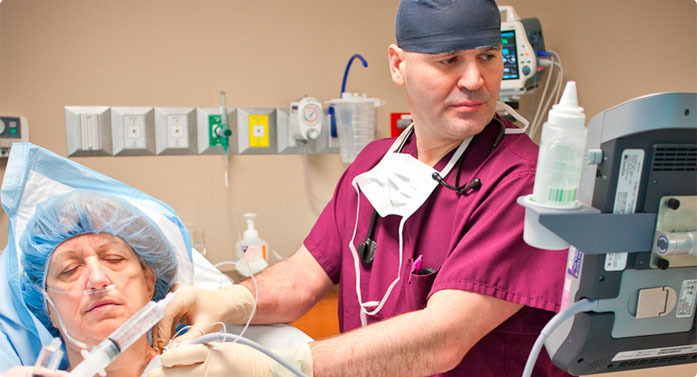Growing Awareness
When Dr. Matusic first started practicing, the block and neurostimulator alone were considered best practise and block success rates of 85% were the accepted norm. "I was using just my own senses and the stimulator," he says. "Even if I had a 10%-15% failure rate, I was still doing better than most."
However, when he became a regional anaesthesiologist in 2010 and began performing orthopaedic nerve blocks exclusively at the Advanced Surgical Hospital, he recognised that even a 10% failure rate would be unacceptable. "We can't afford as many block failures here because we have limited beds—we can't afford to readmit patients for post-op pain."
Dr. Matusic noticed a number of journal publications touting the benefits of ultrasound guidance for regional anaesthesia. When he learned his mentor, Dr. Jacques Chelly, Director of the Acute Orthopaedic Interventional Pain Fellowship at the University of Pittsburgh Medical Centre, was advocating for the technique he decided to learn more.
The Value of Visualisation
Dr. Matusic received training in the requisite skills at a 2010 Ultrasound for Regional Anaesthesia (USRA) course. Soon after, he purchased a Sonosite S-Nerve ultrasound system due to its mobility. "The S-Nerve is amazing. I should never have hesitated to use it," he says. "Why be satisfied with any failed blocks when you can avoid them altogether? With direct visualisation you can actually see why the failure is occurring. For example, I now place nerve blocks that would be for the most part impossible to do without ultrasound guidance, such as an adductor canal approach to the saphenous nerve."
He further states, "Patient satisfaction has improved tremendously. We're getting referrals, and the surgeons report to me that it's a great recruiting tool."
Like many who've transitioned from sceptic to believer, Dr. Matusic isn’t shy about sharing his experiences. "I don't know if the practise would be thriving as well as it is without ultrasound guidance."
Patient Care Benefits
Dr. Matusic reports that because ultrasound enables him to guide the needle directly to the nerve bundle, he has observed the following patient care benefits using his S-Nerve to perform ultrasound-guided nerve blocks:
- A substantial decrease in failed blocks
- Better, more effective blocks with better patient response
- Less anaesthesia required
- Less post-operative pain
- A decrease in post-op nausea and vomiting
- An increase in patient satisfaction (Press Ganey scores in the 90-100% range)
- An increase in patient referrals from physicians associated with other hospitals
- A significant decrease in unplanned re-admissions
“I Almost Felt Like a Hero”
“When I was learning to do ultrasound-guided nerve blocks, I was a little hesitant about my skills, especially with more difficult patients," says Dr. Bryan Matusic. "While working on a patient with an extra-large neck circumference I fell back to performing a traditional block without ultrasound. The block failed.
“During recovery the patient was in severe pain—10 on a scale of 10. With his permission, I performed the block again using the Sonosite system. The needle was much easier to place into position, and after the injection his pain dropped from 10 to zero. He was amazed and incredibly relieved, and of course, so was I.”


